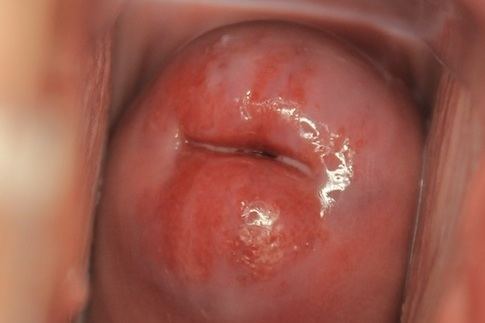Specialty gynaecology DiseasesDB 2288 | ICD-10 N86 | |
 | ||
Cervical ectropion (or cervical eversion) is a condition in which the central (endocervical) columnar epithelium protrudes out through the external os of the cervix and onto the vaginal portion of the cervix, undergoes squamous metaplasia, and transforms to stratified squamous epithelium. Although not an abnormality, it is indistinguishable from early cervical cancer; therefore, further diagnostic studies (e.g., Pap smear, biopsy) must be performed for a differential diagnosis.
Contents
Formation
The squamocolumnar junction, where the columnar secretory epithelium of the endocervical canal meets the stratified squamous covering of the ectocervix, is located at the external os before puberty. As estrogen levels rise during puberty, the cervical os opens, exposing the endocervical columnar epithelium onto the ectocervix. This area of columnar cells on the ectocervix forms an area that is red and raw in appearance called an ectropion (cervical erosion). It is then exposed to the acidic environment of the vagina and, through a process of squamous metaplasia, transforms into stratified squamous epithelium.
Causes
Cervical ectropion is a normal phenomenon, especially in the ovulatory phase in younger women, during pregnancy, and in women taking the oral contraceptive pill, which increases the total estrogen level in the body. It also may be a congenital problem by persistence of the squamocolumnar junction which is normally present prior to birth.
Mucopurulent cervicitis may increase the size of the cervical ectropion.
Symptoms
Cervical ectropion can be associated with excessive but non-purulent vaginal discharge due to the increased surface area of columnar epithelium containing mucus-secreting glands. It may also give rise to post-coital bleeding, as fine blood vessels present within the columnar epithelium are easily traumatised.
Treatment
Usually no treatment is indicated for clinically asymptomatic cervical ectropions. Hormonal therapy may be indicated for symptomatic erosion. If it becomes troublesome to the patient, it can be treated by discontinuing oral contraceptives, or by using ablation treatment under local anaesthetic. Ablation involves using a preheated probe (100 °C) to destroy 3–4 mm of the epithelium. In post-partum erosion, observation and re-examination are necessary for 3 months after labour.
